
India is known for its vast heritage and tradition. Many of these traditions overlap with events and traditions around the globe. Strange enough, traditions in India, by sheer co-incidence or owing to other socio-economic similarities, are a lot like that in other countries. Let’s have a look at some global traditions and how similar they are with the Indian traditions.
Gummatapura (Karnataka) Vs Tomatino (Spain)
In a tiny obscure village in Karnataka-Tamil Nadu border called Gummatapura, is celebrated Gorehabba. Unique it may be but surprisingly, is very similar to the much talked about and the world-famous La Tomatina festival of Spain. The Gorehabba involves the splashing of cow dung, collected by the villagers followed by a number of rituals till the real fun starts. The La Tomatina, is pretty much the same. Rotten tomatoes work for the Spaniards instead. A common fact is that, both tomatoes and cow dung are great for the skin.
Bhaat-ghum (West Bengal) Vs. Siesta (Spain and Latin American countries)
Bhaat-Ghum, or the indispensable afternoon nap of the people of West Bengal has a Spanish name too. It’s called a siesta. This is a practice common in the countries of Italy, China, Greece, North African and the Middle East countries. One of the reasons behind the similarities may be owing to the food habits and hot tropical climate. A bowlful of rice in the afternoon after all, does induce lethargy.
Goddess Saraswati (India) Vs. Benzaiten (Japan)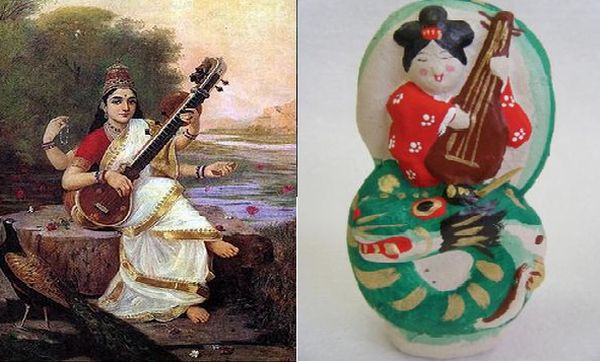
‘She’ holds the Veena and ‘She’ holds a Lute. They represent the forces which flow- music, eloquence, art and water as an element. One is our very own Goddess Saraswati and the other is her Japanese counterpart Benzaiten, to whom the Sutra of Golden Light and the Lotus Sutra are attributed. The Rig Veda states the victory of Saraswati over the three headed Vritra or Ahi, the snake. Commonalities in this case are also found with Benzaiten who happens to be the third daughter of the dragon king Munetsuchi.
Maramadi (Kerala) Vs Bullfighting (Spain)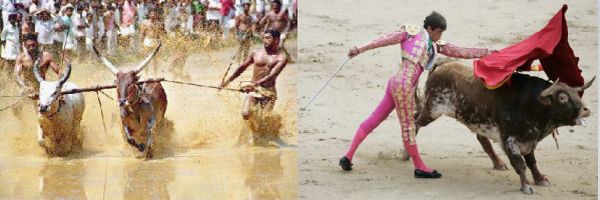
Anandapally, a place located in Kerala, experiences the fascinating agricultural festival of Maramadi. The waterlogged paddy fields see men fighting their bulls, which are representatives of different regions as several onlookers cheer them on, excited villagers gathering around the so-called ‘stadium’. The oxen, participating in this festival are specially fed and brought up. This practice is starkly similar to the ancient sport of Bull fighting, also called Tauromachia, observed in Spain and some other Latin American countries.
Diwali (India) Vs Toro nagashi (Japan)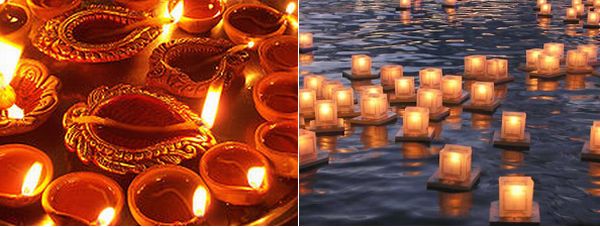
Floating paper lanterns down a river is not the sole practice of Indians as the celebration of the return of Lord Rama to Ayodhya. The Japanese too, follow this tradition in form of a practice known as Toro Nagashi. While toro is synonymous to a traditional lantern, nagashi refers to flowing. Both are the festivals of light despite Diwali celebrating victory and Toro Nagashi commemorating those who lost their lives during World War II in Hiroshima.
Godhbharai (India) Vs Babyshower (USA)
The birth of a baby is a much celebrated occasion around the world, and the joy is shared two weeks before the mother’s due date. Usually hosted by a close female relative or friend, what Indians know as Godhbharai, the Americans know as Baby Shower. Solely a women’s affair, close friends and relatives are invited and a lot of gifts are bestowed upon the to-be mother.
Indian lunar calendar (India) Vs Chinese year cycle (China)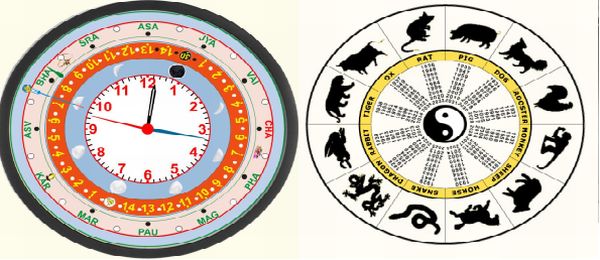
The much celebrated Chinese New Year, a Lunar cycle, is very similar to the way New Year’s is celebrated in India. While the Chinese Lunar calendar has a time cycle of twelve years which reflects the twelve Chinese zodiac signs, the Indians have a thirty years cycle with each year having a different name (Samatsvar).
Mundan (India) Vs First haircut (China)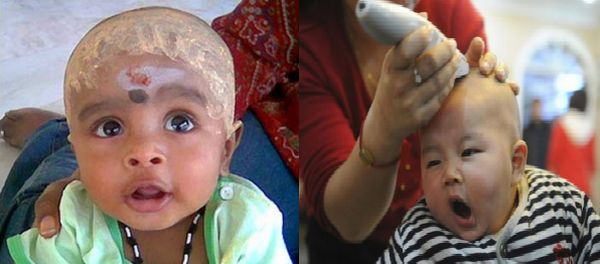
The scientific process of shaving off a baby’s first hair which grows in the womb, has traditional connotations both in China and India. While the Chinese babies get their hair shaved off at the end of the first month, the Indian baby boys are to get their ‘Mundan’ in the first or third year while the baby girls go for it around the age of 11 months, a practice varying from sect to sect.



